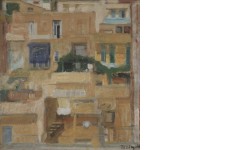艺术家特别信息
标题THE VIEW OF ATHENS FROM XENOKRATOUS STREET
尺寸高度 : 80
宽度 : 74.5
所用材料油画(油画颜料,帆布材质)
签名右下
年表01-01-1965
真伪检验未选中

Footnotes
Painted c. 1963-1965.
Provenance:
Private collection, Athens.
Bathed in the golden glow of the Athenian afternoon, this quintessential Tetsis is a splendid and evocative group portrait of the neoclassical beauties perched on Lycabettus Hill. Following his return from Paris in 1957 and throughout the 1960s, the artist's output was dominated by subjects drawn from Athens: the Houses and Construction Sites (1961), Roofs (1961-1963) and Athens (1961-1970) series. "In this body of work, he is primarily interested in the way light is consumed by the surfaces of the urban volume. Eliminating any specific points of reference, the city is presented to the viewer as a purely personal experience. The porous walls of the weathered neoclassical houses absorb the afternoon light and are soaked in it, conveying the exhilarating vibration of a corporeal optimism that permeates, as an expressive constant, the artist's perception of the urban landscape. Here, the echoes of a post-impressionist vocabulary meet the formal transcription of a luxuriant and diffuse light."1
Reviewing the Tetsis' work in the early 1960s, art critic E. Vakalo keenly observed that "a Greek sense of light nourishes his coloured surfaces and brings them to fruition while at the same time this very sense is nourished in his painting, as a corporeal substance. He introduces into his form the sensation of the Greek landscape and renders the 'Greek' land with a 'European' pictorial attitude."2 This attitude Vakalo refers to is obviously the art of the Nabis, Cezanne, the fauves and the cubist and abstractive experimentations at the beginning of the 20th century, as well as pure abstraction, which by the early 1960s had become the dominant language of the modernist avant-garde. Tetsis' Athenian neighbourhood with its ochre walls and tiled roofs is easily recognizable as a cluster of houses but it can also be read as a nearly abstract sum total of shapes. "Though representational, Tetsis' paintings could not have possibly been created without the experience derived from the knowledge and application of the principles of abstraction."3 Later, in the closing decade of the 20th century, when representational art was no longer relegated to the limbo of philistinism, C. Christou made a similar remark, only reversed: "In all his ventures Tetsis remains a committed expressionist who not only designs with colour but manages to imbue the pictorial surface with the inner quality and expressive potential of colour, without sacrificing visual reality."4
Today, drawing from both modernist and postmodernist discourse, art critic H. Kambouridis holds that "Tetsis muses over colour, loses himself in its depths, and seeks to join the rear-guard of vision, to reach beneath the skin of reality, beyond colour, chroma, a word which derives from the ancient Greek chros meaning skin. Tetsis often transcends the boundaries of technique to let himself drift into the accidental. However, the viewer is hardly ever aware of it, because his paintings always exude a sense of completion despite the non-finito quality of his hasty brushstrokes. A sense of unity and balance, a discreet, subtle classicism lies beneath the romanticism of colour. His eye, well-trained and scholarly, yet innocent and lyrical, contemplates the world through a strong and resolute will for life."5
1. A. Kotidis, 'P. Tetsis: His Work and its Reception' in P. Tetsis, Painting, Nees Morfes gallery, Athens 1999, p. 35.
2. E. Vakalo, "P. Tetsis", Ta Nea daily, 10.11.1961.
3. M. Kalligas, To Vima daily, 16.11.1961.
4. C. Ch(ristou) in Dictionary of Greek Artists [in Greek], Melissa publ., vol. 4, Athens 1999, p. 278.
5. H. Kambouridis, 'A Gymnasium for the Gaze' in P. Tetsis, Thalassa, exhibition catalogue Basil & Elise Goulandris Foundation Museum of Contemporary Art, Andros, 2006, pp. 64-65.